Kaliningrad
Kaliningrad
Калининград | |
|---|---|
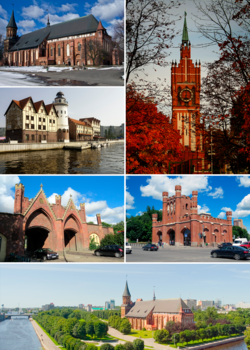 Church of the Holy Family; Königsberg Cathedral; "Fishermen's village" in pseudo-historic style; Brandenburg Gate; King's Gate; Pregolya River | |
|
| |
| Anthem: none[2] | |
| Coordinates: 54°42′01″N 20°27′11″E / 54.70028°N 20.45306°E | |
| Country | Russia |
| Federal subject | Kaliningrad Oblast[1] |
| Founded | September 1, 1255[3] |
| Government | |
| • Body | City Council of Deputies[4] |
| • Head[4] | Alexander Yaroshuk[5] |
| Area | |
| • Total | 223.03 km2 (86.11 sq mi) |
| Elevation | 5 m (16 ft) |
| Population | |
| • Total | 431,402 |
| • Estimate (2018)[7] | 475,056 (+10.1%) |
| • Rank | 40th in 2010 |
| • Density | 1,900/km2 (5,000/sq mi) |
| • Subordinated to | city of oblast significance of Kaliningrad[1] |
| • Capital of | Kaliningrad Oblast,[8] city of oblast significance of Kaliningrad[1] |
| • Urban okrug | Kaliningrad Urban Okrug[9] |
| • Capital of | Kaliningrad Urban Okrug[9] |
| Time zone | UTC+2 (MSK–1 |
| Postal code(s)[11] | 236001, 236003–236011, 236013–236017, 236019–236024, 236028, 236029, 236034–236036, 236038–236041, 236043, 236044, 236700, 236880, 236885, 236890, 236899, 236931, 236950, 236960–236962, 236967, 236970, 236980–236983, 236985, 236989, 236999 |
| Dialing code(s) | +7 4012 |
| OKTMO ID | 27701000001 |
| City Day | July 4; observed on the first Saturday of July |
| Website | www |
Kaliningrad (Russian: Калининград, IPA: [kəlʲɪnʲɪnˈgrat]) (former German name: Königsberg; Russian: Кёнигсберг, tr. Kyonigsberg; Old Prussian: Twangste, Kunnegsgarbs, Knigsberg; Polish: Królewiec; Lithuanian: Karaliaučius) is the administrative center of Kaliningrad Oblast, a Russian semi-exclave between Poland and Lithuania on the Baltic Sea.
In the Middle Ages, it was the site of Old Prussian settlement Twangste. In 1255, during the Northern Crusades, a new fortress was built by the Teutonic Knights. The city became the capital of the Duchy of Prussia and East Prussia (part of Germany). It was heavily damaged during World War II and its population fled or was removed by force when it became a Russian city. According to the 2010 Census, its population was 431,902.[6]
Geography
Kaliningrad is at the mouth of the navigable Pregolya River, which empties into the Vistula Lagoon, an inlet of the Baltic Sea.
Sea vessels can access Gdańsk Bay/Bay of Danzig and the Baltic Sea by way of the Vistula Lagoon and the Strait of Baltiysk.
Until around 1900, ships drawing more than 2 meters (6 ft 7 in) of water could not pass the bar and come into town; larger vessels had to anchor at Pillau (now Baltiysk), where cargo was transferred to smaller vessels. In 1901 a ship canal between Königsberg and Pillau, completed at a cost of 13 million German marks, enabled vessels of a 6.5 meters (21 ft) draught to moor alongside the town (see also Ports of the Baltic Sea).
Khrabrovo Airport, 24 kilometers (15 mi) north of Kaliningrad, has scheduled and charter services to several destinations throughout Europe. There is the smaller Kaliningrad Devau Airport for general aviation. Kaliningrad is also home to Kaliningrad Chkalovsk naval air base.
-
The Pregolya River in Kaliningrad
-
The pseudo-historic "Fishermen's village"
-
13th-century Juditten Church
History
Sambians
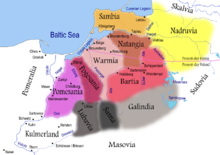
Königsberg was preceded by a Sambian (Old Prussian) fort called Twangste (Tuwangste or Tvankste), meaning Oak Forest.[14] During the conquest of the Sambians by the Teutonic Knights in 1255, Twangste was destroyed and replaced with a new fortress named Königsberg. The declining Old Prussian culture finally became extinct around the 17th century, after the surviving Old Prussians were integrated through assimilation and Germanization.
Königsberg
Old Prussians (until 1255)
Teutonic Order 1255–1466
Teutonic Order 1466–1525 (fief of Poland)
Duchy of Prussia 1525–1657 (fief of Poland)
Duchy of Prussia 1657–1701
Kingdom of Prussia 1701–1871
German Empire 1871–1918
Weimar Germany 1918–1933
Nazi Germany 1933–1945
Soviet Union 1945–1991
Russia 1991-present

Kaliningrad was the East Prussian provincial capital Königsberg. Founded in 1255 by the Teutonic Knights, the city was named in honor of the Bohemian King Ottokar II. Through immigration and development over the following seven centuries, the area became predominantly German, though having Polish and Lithuanian minorities. During World War II the city of Königsberg was heavily damaged by a British bombing attack in 1944 and the massive Soviet siege in spring 1945.
Soviet Union
At the end of World War II in 1945, the city became part of the Soviet Union pending the final determination of territorial questions at the peace settlement (as part of the Russian SFSR) as agreed upon by the Allies at the Potsdam Conference:
The Conference has agreed in principle to the proposal of the Soviet Government concerning the ultimate transfer to the Soviet Union of the city of Koenigsberg and the area adjacent to it as described above, subject to expert examination of the actual frontier.
The President of the United States and the British Prime Minister have declared that they will support the proposal of the Conference at the forthcoming peace settlement.[15]
Königsberg was renamed Kaliningrad in 1946[13] after the death of Chairman of the Presidium of the Supreme Soviet of the USSR, Mikhail Kalinin, one of the original Bolsheviks. The survivors of the German population were forcibly expelled in 1946-1949, and the city was repopulated with Soviet citizens. The German language was replaced by the Russian language.
The city was rebuilt, and, as the westernmost territory of the USSR, the Kaliningrad Oblast became a strategically important area during the Cold War. The Soviet Baltic Fleet was headquartered in the city in the 1950s. Because of its strategic importance, Kaliningrad was closed to foreign visitors.
In 1957 an agreement was signed and later came into force which delimited the border between Poland and the Soviet Union.[16][17]
Russia
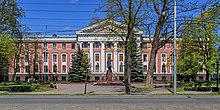


The town of Baltiysk, just outside Kaliningrad, is the only Russian Baltic Sea port said to be "ice-free" all year round, and the region hence plays an important role in maintenance of the Baltic Fleet.
Due to the collapse of the Soviet Union in 1991, the Kaliningrad Oblast became an exclave, geographically separated from the rest of Russia. This isolation from the rest of Russia became even more pronounced politically when Poland and Lithuania became members of NATO and subsequently the European Union in 2004. All military and civilian land links between the region and the rest of Russia have to pass through members of NATO and the EU. Special travel arrangements for the territory's inhabitants have been made through the Facilitated Transit Document (FTD) and Facilitated Rail Transit Document (FRTD).
Since the early 1990s, the Kaliningrad oblast has been a Free Economic Zone (FEZ Yantar). In 2005 the city marked 750 years of existence as Königsberg/Kaliningrad.[18] In July 2007, Russian First Deputy Prime Minister Sergei Ivanov declared that if US-controlled missile defense systems were deployed in Poland, then nuclear weapons might be deployed in Kaliningrad. On November 5, 2008, Russian leader Dmitry Medvedev said that installing missiles in Kaliningrad was almost a certainty.[19] These plans were suspended, however, in January 2009.[20]
But during late 2011, a long range Voronezh radar was commissioned to monitor missile launches within about 6,000 kilometres (3,728 miles). It is situated in the settlement of Pionersky (formerly German Neukuhren) in Kaliningrad Oblast.[21]
Administrative and municipal status
Kaliningrad is the administrative center of the oblast.[8] Within the framework of administrative divisions, it is incorporated as the city of oblast significance of Kaliningrad—an administrative unit with the status equal to that of the districts.[1] As a municipal division, the city of oblast significance of Kaliningrad is incorporated as Kaliningrad Urban Okrug.[9]
City districts
As of 2014[update], the city was divided into three administrative districts:
| City district |
Russian name | Inhabitants 2010 Census[6] |
Notes |
|---|---|---|---|
| Moskovsky | Московский | 152,165 | Named after the Russian capital, Moscow |
| Leningradsky | Ленинградский | 159,771 | named after Leningrad, now Saint Petersburg |
| Tsentralny | Центральный | 119,966 | lit. central, as it lies to the northwest of the historical city center |
Two administrative districts were abolished in June 2009:
| City district |
Russian name | Inhabitants 2002 Census[22] |
Notes |
|---|---|---|---|
| Baltiysky | Балтийский | 68,664 | named after the Baltic Sea |
| Oktyabrsky | Октябрьский | 43,252 | named after the October Revolution |
Climate

Kaliningrad has a temperate climate, Oceanic climate (Cfb), with cool, cloudy, moderate winters and mild summers with frequent showers and thunderstorms. Average temperatures range from −1.5 to +18.1 °C (29.3 to 64.6 °F) and rainfall varies from 36.0 millimeters (1.42 in)/month to 97.0 millimeters (3.82 in)/month. In general, it is a maritime climate and therefore damp, variable and mild. There is still a continental tendency with vast temperature differences between July and January.
The seasons are clearly differentiated. Spring starts in March and is initially cold and windy, later becoming pleasantly warm and often very sunny. Summer, which begins in June, is predominantly warm but hot at times (with temperature reaching as high as +30–+35 °C (86–95 °F) at least once per year) with plenty of sunshine interspersed with heavy rain. The average annual hours of sunshine for Kaliningrad are 1700, similar to other northern cities. July and August are the hottest months. Autumn comes in September and is at first warm and usually sunny, turning cold, damp and foggy in November. Winter lasts from December to March and includes periods of snow. January and February are the coldest months with the temperature sometimes dropping as low as −15 °C (5 °F).
| Climate data for Kaliningrad | |||||||||||||
|---|---|---|---|---|---|---|---|---|---|---|---|---|---|
| Month | Jan | Feb | Mar | Apr | May | Jun | Jul | Aug | Sep | Oct | Nov | Dec | Year |
| Record high °C (°F) | 12.7 (54.9) |
15.6 (60.1) |
23.0 (73.4) |
28.5 (83.3) |
30.6 (87.1) |
33.5 (92.3) |
36.3 (97.3) |
36.5 (97.7) |
33.8 (92.8) |
26.4 (79.5) |
19.4 (66.9) |
13.3 (55.9) |
36.5 (97.7) |
| Mean daily maximum °C (°F) | 0.7 (33.3) |
1.5 (34.7) |
5.6 (42.1) |
12.3 (54.1) |
18.0 (64.4) |
20.5 (68.9) |
23.0 (73.4) |
22.6 (72.7) |
17.6 (63.7) |
12.1 (53.8) |
5.6 (42.1) |
1.9 (35.4) |
11.8 (53.2) |
| Daily mean °C (°F) | −1.5 (29.3) |
−1.1 (30.0) |
2.0 (35.6) |
7.3 (45.1) |
12.5 (54.5) |
15.5 (59.9) |
18.1 (64.6) |
17.6 (63.7) |
13.1 (55.6) |
8.4 (47.1) |
3.3 (37.9) |
−0.3 (31.5) |
7.9 (46.2) |
| Mean daily minimum °C (°F) | −3.9 (25.0) |
−3.6 (25.5) |
−1.1 (30.0) |
2.9 (37.2) |
7.4 (45.3) |
10.9 (51.6) |
13.6 (56.5) |
13.1 (55.6) |
9.2 (48.6) |
5.2 (41.4) |
1.1 (34.0) |
−2.5 (27.5) |
4.4 (39.9) |
| Record low °C (°F) | −32.5 (−26.5) |
−33.3 (−27.9) |
−21.7 (−7.1) |
−5.8 (21.6) |
−3.1 (26.4) |
0.7 (33.3) |
4.5 (40.1) |
1.6 (34.9) |
−2.0 (28.4) |
−11.2 (11.8) |
−18.7 (−1.7) |
−25.6 (−14.1) |
−33.3 (−27.9) |
| Average precipitation mm (inches) | 68 (2.7) |
49 (1.9) |
52 (2.0) |
36 (1.4) |
54 (2.1) |
79 (3.1) |
77 (3.0) |
97 (3.8) |
74 (2.9) |
82 (3.2) |
83 (3.3) |
73 (2.9) |
824 (32.4) |
| Average rainy days | 14 | 13 | 14 | 14 | 14 | 16 | 15 | 16 | 17 | 18 | 18 | 16 | 185 |
| Average snowy days | 15 | 15 | 10 | 3 | 0.1 | 0 | 0 | 0 | 0 | 1 | 7 | 13 | 64 |
| Average relative humidity (%) | 85 | 83 | 78 | 72 | 71 | 74 | 75 | 77 | 81 | 83 | 86 | 87 | 79 |
| Mean monthly sunshine hours | 35 | 61 | 120 | 171 | 253 | 264 | 257 | 228 | 158 | 96 | 38 | 26 | 1,707 |
| Source 1: Pogoda.ru.net[23] | |||||||||||||
| Source 2: NOAA (sun 1961–1990)[24] | |||||||||||||
Cityscape
Museums

Kaliningrad has many museums. A few examples are the Immanuel Kant museum on the Kneiphof island, the Regional Museum of History and Arts, which has parts of Königsberg Castle's Prussia Museum of local archaeological findings, and the Kaliningrad Amber Museum, which is situated in the Dohna Tower near the Rossgarten Gate. The city is also home to the Kaliningrad State Art Gallery, established in 1988, that is developing as a contemporary art museum.[25] The Museum of the World's Oceans is located on the former research vessel Wityaz on the shore of the Pregel river. The museum displays the newest technologies on sea research and also shows the diversity of the flora and fauna of the world's oceans. An anchored Foxtrot-class submarine next to the museum, the B-413, hosts an exhibit about the Russian submarine fleet. [citation needed]
Theatre

The Kaliningrad Philharmonic Orchestra is accommodated in the former Catholic Church of the Holy Family of Königsberg, built in 1907. The church escaped major damage in World War II and was refurbished afterwards. The building, which has noted acoustics, functions as an organ hall since re-opening in 1980.
The Kaliningrad Regional Drama Theater is located in the former Königsberg Neues Schauspielhaus, which was opened in 1910. The building was rebuilt after the war using earlier plans for the theater and opened in 1960. The colonnade in front of the entrance was modeled after the Bolshoi Theater in Moscow.
The regionally notable Kaliningrad Puppet Theater has had its seat since 1975 in the Queen Louise Remembrance Church. This neo-romantic church, designed by architect Fritz Heitmann, was built in 1901.
Architecture

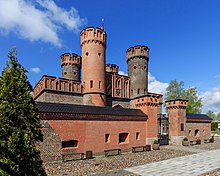
The pre-war city center (Altstadt and Kneiphof) currently consists of parks, broad avenues, a square on the site of the former Königsberg Castle, and two buildings: the House of Soviets ("Dom Sovyetov"), roughly on the site of the former castle, and the restored Königsberg Cathedral on the Kneiphof island (now "Kant island"). Immanuel Kant's grave is situated next to the cathedral. Many German-era buildings in the historic city center have been preserved and even rebuilt, including the reconstruction of the Königsberg Synagogue. The new city center is concentrated around Victory Square. The Cathedral of Christ the Savior, consecrated in 2005, is located on that square.
The oldest building in Kaliningrad is the Juditten Church (built before 1288). Also worth seeing are the former Stock Exchange, the surviving churches, and the remaining city gates. In counter-clockwise order these gates are: the Sackheim Gate, King's Gate, Rossgarten Gate, Attack Gate (German: Ausfallstor, or Sally Port), Railway Gate (Eisenbahntor), Brandenburg Gate, and Friedland Gate (Friedländer Tor (Kaliningrad)). Apart from the already mentioned Dohna Tower, which houses the Amber Museum, the Wrangel Tower also remains as a reminder of the former Königsberg city walls. Only the gate of the former Fort Friedrichsburg remains.
Monuments

Notable monuments include the statue of Immanuel Kant in front of the Immanuel Kant State University of Russia. The statue was made by notable sculptor Christian Daniel Rauch and unveiled in 1864. The statue was destroyed in 1945, but was remoulded in 1992 on the initiative of Marion Dönhoff, a native East Prussian who became prominent in the West. Also worth seeing is the Cosmonaut monument, which honours the Kaliningrad cosmonauts Alexei Leonov, Yuri Romanenko and Aleksandr Viktorenko. Other statues and monuments include the statue for Duke Albert, the statue for Friedrich Schiller, the statue for Tsar Peter the Great, Vladimir Vysotsky, the "Mother Russia" monument, and the Monument for the 1200 Guardsmen, remembering the Battle of Königsberg.
Parks
Kaliningrad is a very "green" city [citation needed] with a large number of parks and areas with lots of trees and lawns. Parks range from tiny city squares to massive parks.
Youth Recreation Park is one of the well known and popular parks in the city. The park was established in 20th-30th in the English style. It reopened its doors post war and was popular among citizens in 80th-90th with its beautiful boat house and tennis courts, as well as merry-go-rounds.[26] The park had a massive reconstruction in 2004 adding to the park a cafe, carting, and various modern entertainments. It is located in the quiet area of the city, in Leningradsky area, and is connected to the Lower Pond. Youth Recreation Park provides entertainment for all age groups. Stroller friendly walks in the green massive for the smallest ones; various entertainment like merry-go-round, butterfly house, house upside down and seasonal ice - skating ring for toddlers and young kids; and picturesque alleys. There is also Interpersonal Communications Development Central located in the park. Its beautiful building became a popular backdrop for wedding pictures.
The Kaliningrad Zoo was opened as the Königsberg Zoo in 1896. The collection, which extends over 16.5 ha, comprises 315 species with a total of 2,264 individual animals (as of 2005[update]). The Kaliningrad Zoo is also an arboretum.
Ponds
Centrally located in the city is Lower Pond, an artificial lake. Lower Pond is surrounded by a promenade and is an area for recreation especially in summer. North of the Lower Pond is the larger Upper Pond in northern Kaliningrad.
Bridges
Leonhard Euler's 1736 paper on the puzzle of the Seven Bridges of Königsberg was a seminal work in the fields of graph theory and topology. Only two of the structures from his era survive.
Culture
Education
An important education centre in Kaliningrad is the Immanuel Kant Baltic Federal University. It is the successor to the Albertina, which was the old university of Königsberg founded in 1544, and whose faculty included noted scholars as Abraomas Kulvietis, Stanislovas Rapalionis, Immanuel Kant, and Jan Mikulicz-Radecki.
Music
The modern city of Kaliningrad is home to the Kaliningrad Regional Philharmonic and Symphony Orchestra, the Lik male chamber choir and the Garmonika Russian music ensemble,[27] as well as the Kaliningrad Chamber Orchestra.[28]
Cuisine

Kaliningrad has its own vodka and beer brands, Stari Königsberg and Ostmark respectively. Since the early 1990s many new restaurants have opened in the city. These restaurants offer culinary specialities of former East Prussia, like Königsberger Klopse, but also many fish and salad dishes, Italian pizza and sushi, which is as popular in Kaliningrad as in the rest of Russia. Königsberger Fleck, a bovine tripe soup and yet another culinary specialty from former Königsberg, no longer belongs to the culinary culture of Kaliningrad.
The people of Kaliningrad generally imported their respective culinary traditions to the region when they settled in the area after 1945. Borshch and okroshka may be served as in the rest of Russia. Many Italian and Asian restaurants (or fusions of both traditions) are in operation all over the city. Pizza and sushi are among the most popular dishes today. Fast food is widely available from various chains, including those of foreign origin: McDonald's and Subway began operations in Kaliningrad in 2011. Shawarma is also gaining considerable prominence.
Transportation
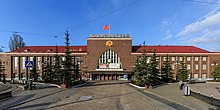

Kaliningrad's Khrabrovo Airport, located near Khrabrovo, mainly connects Kaliningrad to other Russian cities, but also offers flights to other European cities. In Baltiysk, one can take a ferry to St. Petersburg, Stockholm, Copenhagen, Riga, and Kiel. Kaliningrad's international railway station is Kaliningrad Passazhirsky, which in German times was known as Königsberg Hauptbahnhof. Trains depart in the directions of Moscow, Saint Petersburg, Adler and Chelyabinsk. A unique feature of the Kaliningrad railway is that some tracks in the direction of Poland and Berlin have a standard gauge of 1,435-millimeter (56.5 in) track parallel to the commonly Russian broad gauge of 1,520 millimeters (60 in) mostly for strategic reasons during the Cold War and nowadays for goods traffic. Platform number 6 at the Passazhirsky station can be reached on standard gauge over the former Ostbahn main line from Elbing (Elbląg) making passenger through traffic from Berlin possible.
Regional trains also depart from Kaliningrad-North, the former Königsberg Nordbahnhof, which is situated on Victory Square, the current city center. Trains depart to Zelenogradsk and Svetlogorsk, and also once a day to Sovetsk. The lines to the Zelenogradsk and Svetlogorsk have been electrified. Many local pre-war lines have been broken up or are no longer in use, also because the new border with Poland completely disrupted the former traffic flows.
In 1881, the Königsberg tramway system was opened, and it still functions to this day. In 1975, a trolleybus system was also introduced.
-
Mercedes-Benz bus. Pobedy Square (Victory Square)
-
VMZ trolley
-
Port of Kaliningrad
Economy
In 1996, Kaliningrad was designated a Special Economic Zone, referred to as FEZ Yantar. Manufacturers based there get tax and customs duty breaks on the goods they send to other parts of Russia. Although corruption was an early deterrent, that policy means the region is now a manufacturing hub. One in three televisions in Russia is made in Kaliningrad (including Ericsson brand by Telebalt Ltd. and Polar by an eponymous firm located in the city of Chernyakhovsk) and it is home to Cadillac, Hummer and BMW related car plants (produced by Avtotor). Currently, Kaliningrad's major industries are manufacturing, shipping, fishing and amber products. In 2006, Moscow declared it would turn the region into "the Russian Hong Kong".[29]
The European Commission provides funds for business projects under its special programme for Kaliningrad. With an average GDP growth of more than 10% per year for three years to 2007, Kaliningrad grew faster than any other region in Russia, even outstripping the success of its EU neighbours.[citation needed] By early 2015, the BBC reported the region's trade with the countries of the EU was increasing, with improved economic growth and industrial output.[30]
The situation was bad in 2016, the Special Economic Zone expired.[31][32]
Military
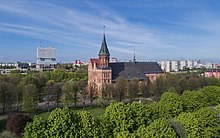

Kaliningrad Oblast used to be the most heavily militarized area of what is now the Russian Federation, and the density of military infrastructure was the highest in Europe. It was the headquarters of the former Soviet Baltic Military District. Kaliningrad also functions as the headquarters of the Russia's Baltic Fleet, ringed by Chernyakhovsk (air base), Donskoye (air base) and Kaliningrad Chkalovsk (naval air base).
Soviet era
Access and control to the Baltic Sea was imperative because of Soviet perceptions that this meant that the hegemonic power had "influence on European and global affairs". Russia had replaced Sweden as the hegemon since the 18th century, but during the late 19th and early 20th century it was increasingly ousted by Germany's growing naval power.[33] At any point in time during the Soviet era, there would be at least 100,000 troops stationed in Kaliningrad (though there are some estimates that run up to 300,000). Therefore, the population of the city was fluid and almost always temporary. Many military officers and their families would refer to the Kaliningrad Oblast as "the West". The Soviet Union also kept nuclear weapons for use in case a war occurred.[34]
Diplomatic missions
In 2004 Germany opened a consulate general in Kaliningrad. This consulate allows Kaliningrad residents to get Schengen visas without having to travel to Moscow. An agreement between Gerhard Schröder, Chancellor of Germany, and President of Russia Vladimir Putin established the consulate in light of Lithuania and Poland, which surround Kaliningrad, joining the EU. Russian concerns with Germany wanting the former Königsberg back had stifled earlier plans for a German consulate.[35]
As of 2004[update] the German consulate was still in the process of getting a new building.[36]
Demographics
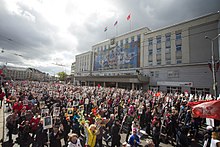
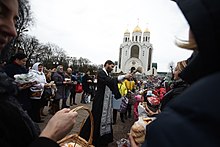
The overwhelming majority Kaliningrad's residents are of Russian ethnicity. As the Soviet Union and the Russian Empire which preceded it were both multi-ethnic states, the area's annexation into the USSR resulted in the city being settled by a slew of other peoples, mostly Slavs. Kaliningrad today is home to communities of Ukrainian, Belarusian, Tatar, German, Armenian, Polish, and Lithuanian descent. Although there is a lack of continuity between the inhabitants of Koenigsberg and contemporary Kaliningrad, these ethnic groups were all present when the city was part of the Polish-Lithuanian Commonwealth.
Ethnic composition, Russian 2010 census:
| Ethnicity | total population | % of the population |
|---|---|---|
| Russians | 351,186 | 87,4 % |
| Ukrainians | 16,053 | 4,0 % |
| Belarusian | 15,077 | 3,7 % |
| Armenians | 3,062 | 0,8 % |
| Tatars | 2,075 | 0,5 % |
| Lithuanians | 1,789 | 0,4 % |
| Germans | 1,676 | 0,4 % |
| Polish | 1,114 | 0,3 % |
| Other ethnicities | 10,041 | 2,5 % |
| All | 401,649 | 100,0 % |
Poles in Kaliningrad
In the 1940s and 1950s the Soviets resettled Poles from Belarus, the Baltic states, Ukraine, and Russia to Kaliningrad.[37] According to Wacław Podbereski after the Second World War and the takeover of the administration in these areas by the Soviets, the development of the Polish element in this region effectively ceased.[38] The oldest church in Königsberg was the Polish church of St. Nicholas, which had been founded with the city in 1255 in the historic district of Steindamm and was dismantled in 1950.[38] Change came with the disintegration of the Soviet Union, due mainly to pastoral activities that began the repolonization of the Poles in Russia. The first steps were made by a Polish priest from Grodno (Hrodna), Fr. Jerzy Steckiewicz.[39]
The "Polish Cultural Community in Kaliningrad" operates as the main Polish organization among Kaliningrad's Polonia, one of six such Polish organizations within Kaliningrad Oblast.[39][40] Wspolnota Polska estimates that it is likely there are between 15,000 and 20,000 Poles living in the entire oblast. The "Polish Cultural Community in Kaliningrad" organizes poetry contests and is the publisher of the local Polish language newspaper "The Voice from the Pregel".[40] The whole Kaliningrad Oblast has witnessed an increase in Polish cultural activity since the fall of the Soviet Union, partly due to the immigration of Polish families from Kazakhstan, who had been deported by Stalin during the Soviet invasion of Poland in 1939.[37]
Sports
Kaliningrad is home to the football club FC Baltika Kaliningrad, which plays in the Football Championship of the National League (formerly Russian First Division). It played in the Russian Premier League for 3 seasons between 1996 and 1998.
Kaliningrad will be the host of some games in the 2018 FIFA World Cup.
Notable people
- Sergey Snegov (1910–1994), science fiction writer
- Viktor Patsayev (1933–1971)
- Alexey Leonov (born 1934), first person to walk in space
- Yury Romanenko (born 1944)
- Alexander Viktorenko (born 1947)
- Oleg Gazmanov (born 1951), singer
- Sergei Beloglazov (born 1956) Olympic wrestler
- Lyudmila Putina (born 1958), ex-wife of Vladimir Putin, First Lady of Russia
- Alexander Volkov (born 1967), tennis player
- Dmitry Lapikov (born 1982), Olympic weightlifter
- Tvangeste, symphonic black metal band
International relations
Small border traffic law
Poland and the Russian Federation have an arrangement whereby residents of Kaliningrad and the Polish cities of Olsztyn, Elbląg and Gdańsk may obtain special cards permitting repeated travel between the two countries, crossing the Polish–Russian border. As of July 2013, Poland had issued 100,000 of the cards. That year, Russians visiting Poland to shop at the Biedronka and Lidl supermarkets featured in songs by musical group Parovoz.[41]
Twin towns and sister cities
Kaliningrad is twinned with[42][43]
Partner cities
Kaliningrad is also partnered with:
See also
- Radio Königsberg
- Seven Bridges of Königsberg
- Heart of the City (Kaliningrad)
- Battle of Königsberg
- Kaliningrad (Königsberg) dispute
References
Notes
- ^ a b c d e Resolution #640
- ^ Article 6 of the Charter of Kaliningrad states that the city may have an anthem, providing one is officially adopted. As of 2015[update], an anthem is not listed among the symbols of the city shown on the official website of Kaliningrad.
- ^ a b c Official website of Kaliningrad. Passport of Kaliningrad Urban Okrug. Template:Ru icon
- ^ a b Charter of Kaliningrad, Article 25
- ^ Official website of Kaliningrad. Head of the City, Alexander Georgiyevich Yaroshuk. Template:Ru icon
- ^ a b c Russian Federal State Statistics Service (2011). Всероссийская перепись населения 2010 года. Том 1 [2010 All-Russian Population Census, vol. 1]. Всероссийская перепись населения 2010 года [2010 All-Russia Population Census] (in Russian). Federal State Statistics Service.
- ^ "26. Численность постоянного населения Российской Федерации по муниципальным образованиям на 1 января 2018 года". Federal State Statistics Service. Retrieved January 23, 2019.
- ^ a b Law #463
- ^ a b c Law #397
- ^ "Об исчислении времени". Официальный интернет-портал правовой информации (in Russian). June 3, 2011. Retrieved January 19, 2019.
- ^ Почта России. Информационно-вычислительный центр ОАСУ РПО. (Russian Post). Поиск объектов почтовой связи (Postal Objects Search) (in Russian)
- ^ Kaliningrad Oblast Territorial Branch of the Federal State Statistics Service. Оценка численности населения Калининградской области по состоянию на 1 января 2014 года Template:Ru icon
- ^ a b Decree of July 4, 1946
- ^ The Monthly Review. R. Griffiths. 1836. p. 609. Retrieved December 29, 2014.
- ^ "THE POTSDAM DECLARATION". ibiblio.org. Retrieved December 29, 2014.
- ^ "Russia (USSR) / Poland Treaty (with annexed maps) concerning the Demarcation of the Existing Soviet-Polish State Frontier in the Sector Adjoining the Baltic Sea 5 March 1957" (PDF). un.org. Retrieved December 29, 2014.
- ^ For other issues of the frontier delimitation see "Maritime boundary delimitation agreements and other material". un.org. Retrieved December 29, 2014.
- ^ "The New York Times". nytimes.com. Retrieved December 29, 2014.
- ^ "Medvedev Says Russia to Deploy Missiles Near Poland" Associated Press via Yahoo News [dead link]
- ^ Luke Harding in Moscow (January 28, 2009). ""Russia scraps plans to deploy nuclear-capable missiles in Kaliningrad" The". Guardian. Retrieved December 21, 2013.
- ^ 28.11.2011 (November 28, 2011). ""Russia's new radar to monitor all Europe including Britain" Pravda 28.11.2011". English.pravda.ru. Retrieved December 21, 2013.
{{cite web}}:|author=has numeric name (help) - ^ Federal State Statistics Service (May 21, 2004). Численность населения России, субъектов Российской Федерации в составе федеральных округов, районов, городских поселений, сельских населённых пунктов – районных центров и сельских населённых пунктов с населением 3 тысячи и более человек [Population of Russia, Its Federal Districts, Federal Subjects, Districts, Urban Localities, Rural Localities—Administrative Centers, and Rural Localities with Population of Over 3,000] (XLS). Всероссийская перепись населения 2002 года [All-Russia Population Census of 2002] (in Russian).
- ^ "Weather and Climate-The Climate of Kaliningrad" (in Russian). Погода и климат. Retrieved April 5, 2016.
- ^ "Kaliningrad Climate Normals 1961–1990". National Oceanic and Atmospheric Administration. Retrieved April 5, 2016.
- ^ "Kaliningrad State Art Gallery". www.russianmuseums.info. 2014. Retrieved June 21, 2014.
- ^ "Новости! Анонсы! Акции! | Парк "Юность", г.Калининград". www.park-unost.ru. Retrieved August 18, 2017.
- ^ "Russia's Daily Online". Kommersant. Retrieved June 27, 2009.
- ^ "Shostakovich & Schnittke Concertos". Classicstoday.com. Retrieved January 31, 2014.
- ^ Sheeter, Laura (October 16, 2006). "'Kaliningrad erases stains of past' 16 October 2006". BBC News. Retrieved December 21, 2013.
- ^ "'Regions and territories: Kaliningrad' 18 December 2007". BBC News. October 5, 2013. Retrieved December 21, 2013.\
- ^ [1]
- ^ [2]
- ^ Knudsen, Olav F. (1999). Stability and Security in the Baltic Sea Region. Portland, OR: Frank Cass & Co. Ltd. p. 38. ISBN 0-7146-4932-5.
- ^ Krickus, Richard (2002). The Kaliningrad Question. Lanham, Maryland: Rowman & Littlefield Publishers, Inc. p. 42.
- ^ "Fischer Establishes German Outpost in Kaliningrad." Deutsche Welle. 12 February 2004. Retrieved on 16 May 2016.
- ^ Kovalev, Vladimir. "No Building for German Consulate." The Moscow Times. August 30, 2004. Retrieved on May 16, 2016.
- ^ a b Wspólnota Polska (December 17, 2012). "Stowarzyszenie Wspólnota Polska". Archiwum.wspolnotapolska.org.pl. Retrieved March 12, 2013.
- ^ a b Wacław Podbereski, Sąsiedzi: Królewiec – Koenigsberg – Kaliningrad [w:] "Znad Wilii" nr 4(44) 2010, s. 113-117
- ^ a b "Placówki Dyplomatyczne Rzeczypospolitej Polskiej". Kaliningradkg.polemb.net. Retrieved December 21, 2013.
- ^ a b "Consulate General in Kaliningrad". Kaliningradkg.polemb.net. Retrieved December 21, 2013.
- ^ A.C. (October 8, 2013). "Poland and Kaliningrad: Small Border Traffic". Economist blog. Archived from the original on October 8, 2013. Retrieved December 29, 2014.
{{cite news}}: Unknown parameter|dead-url=ignored (|url-status=suggested) (help) - ^ a b "Города-партнёры" (in Russian). Kaliningrad City Hall. Archived from the original on April 22, 2009. Retrieved December 8, 2008.
{{cite web}}: Unknown parameter|deadurl=ignored (|url-status=suggested) (help) - ^ Luhn, Alec (November 20, 2011). "Kaliningrad". The Moscow Times. Retrieved February 26, 2016.
- ^ "Aalborg Twin Towns". Europeprize.net. Archived from the original on September 7, 2013. Retrieved August 19, 2013.
{{cite web}}: Unknown parameter|deadurl=ignored (|url-status=suggested) (help) - ^ "Kaliningrad information". E-gorod.ru. Retrieved December 21, 2013.
- ^ Korolczuk, Dariusz (January 12, 2010). "Foreign cooperation - Partner Cities". Białystok City Council. City Office in Białystok. Retrieved March 22, 2013.
- ^ "Elbląg - Podstrony / Miasta partnerskie". Elbląski Dziennik Internetowy (in Polish). Archived from the original on March 15, 2011. Retrieved December 29, 2014.
{{cite web}}: Unknown parameter|deadurl=ignored (|url-status=suggested) (help) - ^ "Elbląg - Miasta partnerskie". Elbląg.net (in Polish). Retrieved August 1, 2013.
- ^ "Gdańsk Official Website: 'Miasta partnerskie'". gdansk.pl (in Polish and English). Urząd Miejski w Gdańsku. 2009. Archived from the original on July 23, 2013. Retrieved July 11, 2009.
{{cite web}}: Unknown parameter|deadurl=ignored (|url-status=suggested) (help) - ^ P.C., Net. "Gdynia - International Gdynia - International co-operation of Gdynia". www.gdynia.pl. Archived from the original on October 19, 2016.
{{cite web}}: Unknown parameter|deadurl=ignored (|url-status=suggested) (help) - ^ "Groningen - Partner Cities". © 2008 Gemeente Groningen, Kreupelstraat 1,9712 HW Groningen. Archived from the original on September 26, 2007. Retrieved December 8, 2008.
{{cite web}}: Unknown parameter|deadurl=ignored (|url-status=suggested) (help) - ^ "Miasta partnerskie - Urząd Miasta Łodzi". City of Łódź (in Polish). Archived from the original on June 24, 2013. Retrieved December 29, 2014.
{{cite web}}: Unknown parameter|deadurl=ignored (|url-status=suggested) (help) - ^ "Vänorter" (in Swedish). Malmö stad. Archived from the original on December 3, 2013. Retrieved November 6, 2013.
{{cite web}}: Unknown parameter|deadurl=ignored (|url-status=suggested) (help) - ^ "Miasta bliźniacze Torunia". Urząd Miasta Torunia [City of Toruń Council] (in Polish). Retrieved August 22, 2013.
{{cite web}}: Unknown parameter|trans_title=ignored (|trans-title=suggested) (help) - ^ Kalingrad and Patras to become twin cities
- ^ Russian Sailing Ship Docks in Patras for Twinning with Kaliningrad
- ^ "Yerevan - Partner Cities". Yerevan Municipality Official Website. ©2005–2013 www.yerevan.am. Archived from the original on November 5, 2013. Retrieved November 4, 2013.
{{cite web}}: Unknown parameter|deadurl=ignored (|url-status=suggested) (help)
Sources
- Городской Совет депутатов Калининграда. Решение №257 от 12 июля 2007 г. «О принятии Устава городского округа "Город Калининград"», в ред. Решения №20 от 17 февраля 2017 г. «О внесении изменений и дополнений в Устав городского округа "Город Калининград", утверждённый Решением городского Совета депутатов Калининграда от 12 июля 2007 г. №257». Вступил в силу 22 июля 2007 г. (за исключением отдельных положений). Опубликован: "Гражданин" (специальный выпуск), №12, 21 июля 2007 г. (City Council of Deputies of Kaliningrad. Decision #257 of July 12, 2007 On Adopting the Charter of the Urban Okrug of the "City of Kaliningrad", as amended by the Decision #20 of February 17, 2017 On Amending and Supplementing the Charter of the Urban Okrug of the "City of Kaliningrad", Adopted by Decision #257 by the City Council of Deputies of Kaliningrad Decision on July 12, 2007. Effective as of July 22, 2007 (with the exception of certain clauses).).
- Калининградская областная Дума. Закон №463 от 27 мая 2010 г. «Об административно-территориальном устройстве Калининградской области», в ред. Закона №450 от 3 июля 2015 г. «О внесении изменений в Закон Калининградской области "Об административно-территориальном устройстве Калининградской области"». Вступил в силу со дня официального опубликования. Опубликован: "Калининградская правда" (вкладыш "Ведомости Правительства Калининградской области"), №112, 26 июня 2010 г. (Kaliningrad Oblast Duma. Law #463 of May 27, 2010 On the Administrative-Territorial Structure of Kaliningrad Oblast, as amended by the Law #450 of July 3, 2015 On Amending the Law of Kaliningrad Oblast "On the Administrative-Territorial Structure of Kaliningrad Oblast". Effective as of the day of the official publication.).
- Правительство Калининградской области. Постановление №640 от 30 августа 2011 г. «Об утверждении реестра объектов административно-территориального деления Калининградской области», в ред. Постановления №877 от 21 ноября 2011 г «О внесении изменения в Постановление Правительства Калининградской области от 30 августа 2011 г. №640». Вступил в силу со дня официального опубликования. Опубликован: "Калининградская правда" (вкладыш "Официально"), №170, 15 сентября 2011 г. (Government of Kaliningrad Oblast. Resolution #640 of August 30, 2011 On the Adoption of the Registry of the Objects of the Administrative-Territorial Divisions of Kaliningrad Oblast, as amended by the Resolution #877 of November 21, 2011 On Amending the Resolution of the Government of Kaliningrad Oblast #640 of August 30, 2011. Effective as of the day of the official publication.).
- Калининградская областная Дума. Закон №397 от 15 мая 2004 г. «О наделении муниципального образования "Город Калининград" статусом городского округа», в ред. Закона №370 от 1 июля 2009 г «О составе территорий муниципальных образований Калининградской области». Вступил в силу со дня официального опубликования. Опубликован: "Российская газета" ("Запад России"), №115, 3 июня 2004 г. (Kaliningrad Oblast Duma. Law #397 of May 15, 2004 On Granting the Urban Okrug Status to the Municipal Formation of the "City of Kaliningrad", as amended by the Law #370 of July 1, 2009 On the Composition of the Territories of the Municipal Formations of Kaliningrad Oblast. Effective as of the day of the official publication.).
- Vesilind, Priit J. "Kaliningrad: Coping with a German Past and a Russian Future", National Geographic, March 1997.
- Berger, Stefan "A City and Its Past. Popular Histories in Kaliningrad between Regionalization and Nationalization", in: Popularizing National Past. 1800 to Present, Edited by Stefan Berger, Chirs Lorenz, and Billie Melman, Routledge 2012, pp. 288–307.
- Kaliningrad Region, General Information Kommersant, Russia's daily On-line
- Президиум Верховного Совета СССР. Указ от 4 июля 1946 г. «О переименовании города Кёнигсберга в город Калининград и Кёнигсбергской области в Калининградскую область». (Presidium of the Supreme Soviet of the USSR. Decree of July 4, 1946 On Changing the Name of the City of Kyonigsberg to the City of Kaliningrad and the Name of Kyonigsberg Oblast to Kaliningrad Oblast. ).
Further reading
- Liuhto, Kari (editor). "Its future competitiveness and role in the Baltic Sea economic region." University of Turku.
- Rogoża, Jadwiga, Agata Wierzbowska-Miazga, and Iwona Wiśniewska. "A captive island. Kaliningrad between Moscow and the EU." OSW Studies, No. 41, July 2012.
External links












